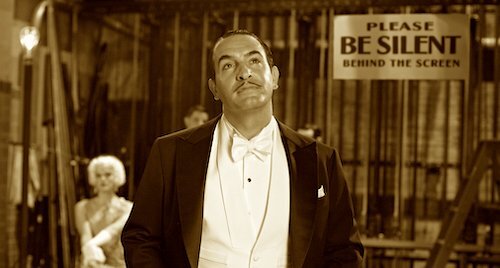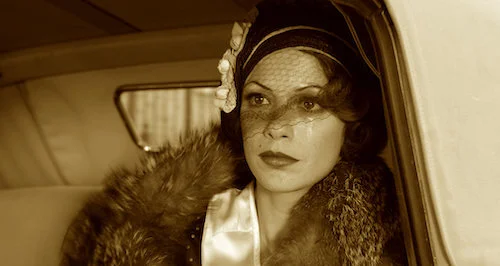The Artist
This review is a part of the Best Picture Project: a review of every single Academy Award winner for the Best Picture category. The Artist is the eighty forth Best Picture winner at the 2011 Academy Awards.
The decade started off with a set precedent: works that look backwards. The Love Witch evokes the corniness and visual richness of the ‘60s era. The Lighthouse was intentionally shot with a square ratio, and choppily, to mimic old horror pictures. Stranger Things was a television show hellbent on bringing back the look and feel of ‘80s sci fi. Not that The Artist was the first film of the 2010’s to recreate an older time period of the visual medium, but it’s difficult to think of any other film making a bigger impact in this decade. Its Academy history was impactful enough. It is the first silent film to win Best Picture since Wings. Yep. The very first Best Picture winner. It is the first black and white film since Schindler’s List (or The Apartment, if you disregard the bits of colour in List). There are other tech-specific records The Artist set.
In 2020, no one is talking about The Artist. No one is talking about the film, director Michel Hazanavicius, or stars Jean Dujardin and Bérénice Bejo. What happened? I’ve seen The Artist pop up a few times in the best-of-the-decade discussion (it sure as hell made my list), but I feel that this experiment deserves better. Luckily, I was young enough to be naive and just be excited for a modern silent film. Had The Artist come out a few years later, maybe I would have been more skeptical. I also remember the stupidest of headlines that were coming out around this time, which only propelled The Artist into the very top echelons of the awards season. These include pundits that were worried that there would be more silent films after this one. Did they even watch The Artist? Like, at all?
George Valentin waiting for the response of his latest film.
The Artist is a statement on a shifting film industry, that could only make sense as a silent film (also, news flash: if these “analysts” actually viewed the film, they would know that it is not authentically a silent film after all). Hazanavicius wanted to tell the tale of a film star that experienced their own downfall due to their stubbornness to embrace change (or fear of not being able to make it to the other side during the transition to talking pictures). As silent star George Valentin dismisses the innovation of talkies, his own career gets worse and worse. All the while, rising starlet Peppy Miller is eclipsing Valentin in the same studio, although she means to bring him up with her to the spotlight (she thanks Valentin for her start, after all). Sound begins to plague Valentin; he even begins to have nightmares with audible noises (which we, the audience, can hear).
So much of The Artist is clever; enough to dispel how much of the film rides on the coattails of its central gimmick. The effects for particular scenes (I’m thinking Valentin’s drunken hallucinations) authentically capture the visual trickery used in the silent era. Other charming moments (Miller wearing part of Valentin’s jacket to embrace herself) feels like something straight out of a visual-cued picture (say, a Charlie Chaplin classic). The title cards used embrace the effectiveness of the old methods of artistic communication in cinema; it’s as if every single title card is fine tuned to extract as much substance out of the film as possible (that “bang” cue is one of the best I’ve seen in any silent picture. I’m serious). We’ve seen films tackle the transformations of Hollywood before, especially Singin’ in the Rain approach the exact same subject of talkies taking over the film industry. The Artist is still a unique representation, that has imagination at every corner.
An emotional Peppy Miller.
Hazanavicius is also self aware (see his OSS films for reference), and uses The Artist to channel various film influences. The most infamous example is a slice of the score in Alfred Hitchcock’s Vertigo, which drew a highly vicious remark from star Kim Novak. Toss in a line or two from other films, and you have a reference of Hollywood that also greatly appreciates the ground that has since been covered from the era The Artist is depicting. I see a sincerity with that, especially with the interpolation of these moments in different ways. The ultimate send off is the meta ending, which wraps up a silent adventure thus far in the most magical way The Artist could possibly finish. With all of the above in mind, I can’t see how The Artist couldn’t blow someone away, let alone this final conventions-breaking twist.
And yet, here we are. The Artist has been cast aside since its awards season domination throughout 2011 and 2012. Had The Artist just been a lazy niche film, I would understand. It is far from that, though. It’s so beautifully constructed. It surpasses its highly possible limitations in every single way. It gets its message across inventively. As a risk taken in 2011, I think The Artist pays off in pretty much every way, because Michel Hazanavicius still wanted to make a good film first and foremost. If anything, its success and singular style should allow it to remain a pivotal moment in the 2010’s. Don’t let the subsequent awards seasons brush away this witty, glorious tribute to Hollywood. It demands to have a legacy of at least some sort.
Andreas Babiolakis has a Masters degree in Film and Photography Preservation and Collections Management from Ryerson University, as well as a Bachelors degree in Cinema Studies from York University. His favourite times of year are the Criterion Collection flash sales and the annual Toronto International Film Festival.







